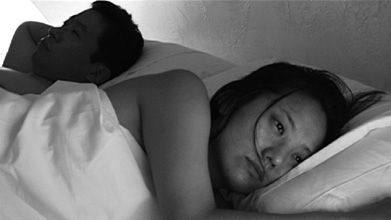Nakta(dul)
Camel(s)
Park Ki-Yong
Korea 2001

|
Delphi |
Weltvertrieb: e pictures, 10-12 Hehwa-Dong,
Jongro-Gu, Seoul 110-530, Korea
Tel.: (82-2) 3673 2545, Fax: 3673 2544
e-mail: sylee@ep-korea.com
Buch: Park Ki-Yong
Kamera: Choi Chan-Min
Musik: Park Jin-Suk
Schnitt: Park Ki-Yong, Kim Sung-Soo
Darsteller: Lee Dae-Yeon, Park Myung-Shin
Format: 35 mm, 1:1.66, s/w
Länge: 92 Minuten, 25 B/Sek.
Sprache: koreanisch
Camel(s) ist ein Film ohne Geschichte, mit einer sparsamen Handlung. Ein Paar mittleren Alters verbringt eine Nacht in einer kleinen Stadt am Meer in der Nähe von Seoul. Beide haben Familie und verbinden Erinnerungen mit diesem Ort, der zu ihrer Schulzeit ein Fleck auf der Landkarte war und nun überfüllt ist mit Fischrestaurants, Karaokebars und Stundenhotels. Park Ki-Yong: „Zu Beginn der Dreharbeiten existierte nur ein kurzer Abriss der Handlung: der Hintergrund der Figuren, wie sie sich getroffen haben, auf eine Wochenendreise gehen und was sie in der Nacht am Meer unternehmen. Das Ende war offen. Danach suchten wir zuerst den Drehort aus, dann diskutierten wir eine Zeit lang über die Dialoge der Figuren und was für Gefühle sie an diesem Ort bewegen. Den Rest entschieden die Schauspieler. Die Crew – auch ich – ließ sich überraschen. Ich glaube, dass diese Art der Improvisation, wie bei Jazz-Musikern, der entscheidende Faktor dieses kleinen Digitalfilms ist. Ich wollte nichts von Anfang an festlegen und habe versucht, alle konventionellen Methoden des Filmemachens soweit wie mölich zu umgehen. Das Schlüsselbild während der Dreharbeiten waren für mich Kamele, die geistesabwesend durch die Wüste ziehen. Das Plural-S erklärt sich aus der Tatsache, dass die Frau und der Mann zwar zusammen sind, aber sie wissen, dass sie nur eine kurze Zeit gemeinsam verbringen werden.“
Park Ki-Yong, geb. 1961 in Südkorea. Filmstudium am Seoul Institute of the Arts und an der Korea Film Academy. Verschiedene Funktionen bei der Produktion von Werbe-, Dokumentar-> und Spielfilmen. Filmregie bei Motel Cactus (Forum 1998). Camel(s)ist sein zweiter Spielfilm.